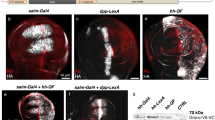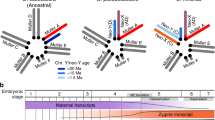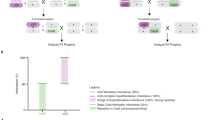Abstract
The TE1 family of transposable elements (TEs) of Drosophila consists of unusually large transposons, cytologically visible in larval polytene chromosomes as one or more bands1–3. They are composite elements, as their termini consist of foldback (FB) sequences which are themselves transposable4–6. The location of FB elements at the termini of transposable elements suggests that these sequences have a direct role in the genetic instability of TEs. To investigate the structural and phenotypic consequence of TE excision, we have cloned genomic DNA required for the expression of the no-ocelli (noc) gene of Drosophila; this gene has been mutated by the insertion of TE146, a member of the TE1 family carrying six polytene chromosome bands including functional copies of the white (w+) and roughest (rst+) genes. As reported here, our experiments indicate that the spontaneous excision of TE146, which results in the loss of the w+ and rst+ markers, can occur either as a single-step event or following a partial internal deletion. In either case, the end product is an imprecise excision in which a residual portion of the element, varying in size from 3 to 10 kilobases (kb), is left at the insertion site. These residual sequences share homology with the FB family. Furthermore, despite their imprecise nature, all these spontaneous excisions restore a wild-type noc+ phenotype.
This is a preview of subscription content, access via your institution
Access options
Subscribe to this journal
Receive 51 print issues and online access
$199.00 per year
only $3.90 per issue
Buy this article
- Purchase on Springer Link
- Instant access to full article PDF
Prices may be subject to local taxes which are calculated during checkout
Similar content being viewed by others
References
Ising, G. & Ramel, C. in The Genetics and Biology of Drosophila Vol. 1b (eds Ashburner, M. & Novitski, E.) 947–954 (Academic, New York, 1976).
Ising, G. & Block, K. Cold Spring. Harb. Symp. quant. Biol. 45, 527–551 (1981).
Ising, G. & Block, K. Molec. gen. Genet. 196, 6–16 (1984).
Potter, S. S., Truett, M., Phillips, M. & Maher, A. Cell 20, 639–647 (1980).
Truett, M. A., Jones, R. S. & Potter, S. S. Cell 24, 753–763 (1981).
Goldberg, M. L., Paro, R. & Gehring, W. J. EMBO J. 1, 235–252 (1982).
Gubb, D. et al. Genetics (submitted).
Ashburner, M., Aaron, C. S. & Tsubota, S. Genetics 102, 421–435 (1982).
Bender, W., Spierer, P., Spierer, A. & Hogness, D. J. molec. Biol. 168, 17–34 (1983).
Goldberg, D. Proc. natn. Acad. Sci. U.S.A. 77, 5794–5798 (1981).
Maniatis, T. et al. Cell 15, 687–701 (1978).
Collins, M. & Rubin, G. M. Nature 308, 323–327 (1984).
Levis, R. & Rubin, G. M. Cell 30, 543–550 (1982).
Paro, G., Goldberg, M. L. & Gehring, W. J. EMBO J. 2, 853–860 (1983).
Gubb, D., Shelton, M., Roote, J., McGill, S. & Ashburner, M. Chromosoma 91, 54–64 (1984).
Author information
Authors and Affiliations
Rights and permissions
About this article
Cite this article
Chia, W., McGill, S., Karp, R. et al. Spontaneous excision of a large composite transposable element of Drosophila melanogaster. Nature 316, 81–83 (1985). https://doi.org/10.1038/316081a0
Received:
Accepted:
Issue Date:
DOI: https://doi.org/10.1038/316081a0
This article is cited by
Comments
By submitting a comment you agree to abide by our Terms and Community Guidelines. If you find something abusive or that does not comply with our terms or guidelines please flag it as inappropriate.



